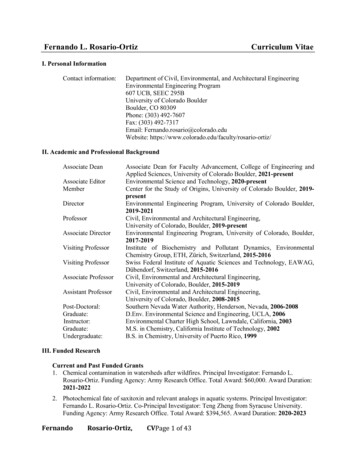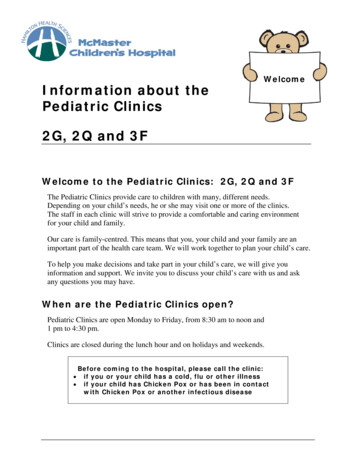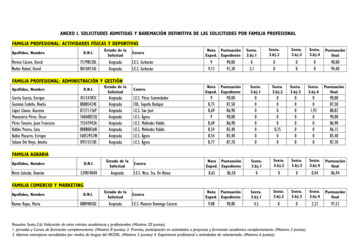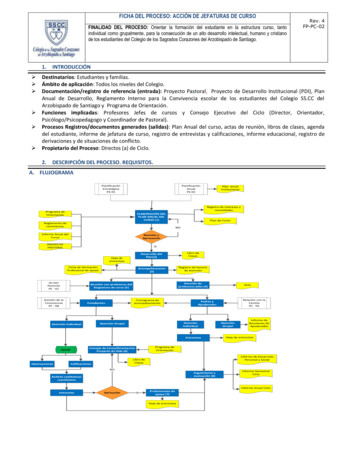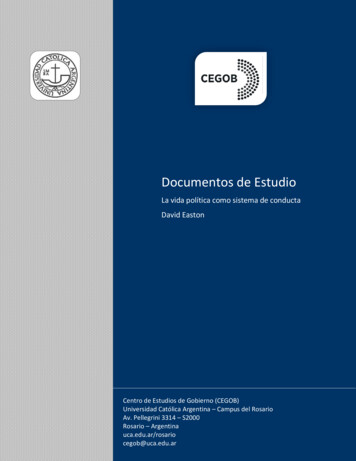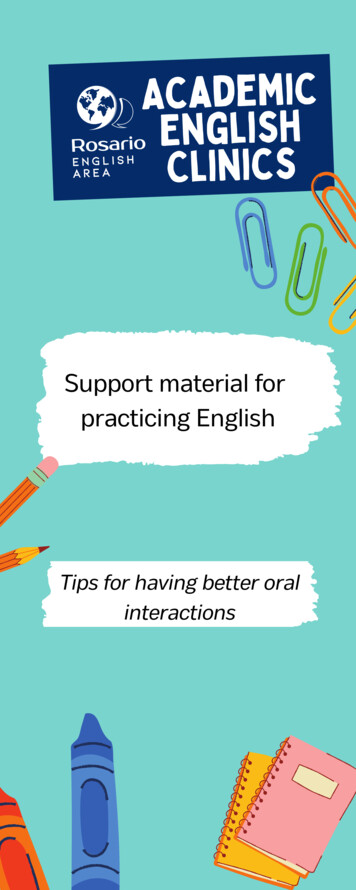
Transcription
AcademicEnglishClinicsSupport material forpracticing EnglishTips for having better oralinteractions
Academic SpeakingCommonlymispronouncedWordsWhen we learn a new language, there are high probabilities that wemispronounce words when speaking. That is okay, it is part of the learningprocess. However, we need to wonder if the way we pronounce words iscorrect, and, if it is not, we need to work on the correction. Having anappropriate pronunciation is important in language learning because whenpronunciation is incorrect, communication might be broken.Nevertheless, correcting pronunciation is a difficult task for different reasons.First, other speakers – including our own teachers – might mispronouncewords. Second, generally during an interaction, speakers do not correctpronunciation as long as they understand the message. Finally, we are notreally experts in the field of phonetics and phonology.We can, however, work on improvingpronunciation with some little tricks.The easiest one is to check thecorrect pronunciation of a word onthe internet. All you need to do is toclick on any browser something like:“XX pronunciation” and we will havean immediate answer.But, if you want to understand thepronunciation better, you can explorethe phonetic transcription of the wordyou want to pronounce accurately.There, you will find some elementsthat will tell you the correctpronunciation of a word such as theindividual sounds and the stress in theword:This symbol represents the estress or emphasis in the word.Example: In the word Scaffolding, the stress is on the firtssyllable: SCAffoldingScaffolding/ˈs k æ f ə l d ɪ ŋ/Some examples of mispronounced words are:Determine /dəˈtɜrmən/Category /ˈkætəˌgɔri/Economics /ɛkəˈnɑmɪks/Organize /ˈɔrgəˌnaɪz/Politics /ˈpɑləˌtɪks/Pedagogy /ˈpɛdəˌgoʊʤi/Television /ˈtɛləˌvɪʒən /Researcher /ˈrisərʧər/
Academic SpeakingLevels of.Formalitythree levels of formalityFormal1"Could I disturb you for a minute?"It shows politeness, respect and distance.Neutral2"Can I ask you something?"It does not have a formal or an informal tone.InformalYou got a sec?3It shows that the speaker is familiar with thereceptor and there is not a need or effort tobe polite or respectful.Directness in Formal and Informal EnglishFormal language: Tends to be much more indirect. Oftensounds impersonal. Uses fewer personal pronouns.Informal language: Tends to be more direct and personal.Neutral language: Tends to be partly personal and partlyindirect.is in the middle, similar to other situations you’ve seen.Adapted from Oxford Online English.
Academic SpeakingExpressingOpinionIf you want to participate effectively in an academic discussion, youwill need to make your ideas clear. This means you will have to voice(or give) your opinion. Some useful expressions to use whenexpressing your opinion:I thinkA more informalway of givingyour opinion.In my opinionin my viewUsed for givingyour opinion whenyou have thoughtcarefully about asituation.The most usualand general wayof giving youropinion.I reckonA more formalway of givingyour opinion.It seems to meAll things consideredGiving opinion intermediate and advancedIntermediateAdvancedI’m absolutely certain that This is just my opinion, but I’m fairly confident that Without a doubt, I’m no expert (on this), but You probably won’t agree, but I’m positive that I’m pretty sure that I could be wrong, but My (point of) view (on this) is I’d definitely say that I’d say that There is a part of me that says I know this is a minority view, but / I’min the minority in thinking that This may well be controversial, but To my mind / To my way of thinking, .I tend towards the opinion that To summarize my (rather complex)views on the matter, I think it’s fair/reasonable to say I’ll tell you what I think, What I always say is Academic Source: EAPfoundation.comhttps://www.englishclub.com/
Academic SpeakingLinkingParagraphsAn important characteristic in writing is coherence. For coherencein writing, the sentences must hold together; that is, the transitionbetween one sentence to the next one must be logical and smooth.The same level of coherence must be used in connectingparagraphs. Linking paragraphs with transition words orsentences help the reader better understand how subtopics areconnected. This connection can be done in two different ways: a.ending a paragraph with a sentence that connects with the firstsentence of the next paragraph, and b. Starting a new paragraphlinking the idea to the previous paragraph.Whether you decide to link paragraphs using any of the twomentioned approaches, the transition can be signaled by a singleword, a phrase, or a dependent clause that summarizes an idea.le wordsExamples of singconnectors:tion phrase:Examples of transiOne wayAnother wayHoweverThis meansIn additionThe first reason istageAnother disadvanIn addition to Even though One problem withhat) Keeping in mind (tdel of X, .Following the mocation on lipimtnaicifngsiAis clause:nioitsnatrfoleExampenceDespite the evidfact thatpointing to thekey elementmotivation is aprocess, in any learningifficult to sayAlthough it is dcation leadsudexe-sleginsifs in testto better resultscores, Taken From: Oshima, A., Hogue, A., & Ravitch, L. (2014). Longman Academic Writing Series, Level 4: Essays.White Plains, NY: Pearson Education.
Academic SpeakingThe ArgumentativeEssayAn argumentative essay is one in which there is an agreement or disagreement withan issue, using reasons to support an opinion. The goal is to convince the audiencethat one’s point of view is right. An argumentative essay has three different sections:an introductory paragraph, the body (summary of the opposite arguments, rebuttalsto the opposing arguments, your own arguments), and a conclusion.Introduction:The introductory paragraph contains an explanation of the issue and thesis statement. Theexplanation of the issue is an essential part of the introduction as it provides the backgroundof the issue to discuss. On the other hand, the thesis statement clearly states your point ofview. The thesis statement often mentions the opposing point of view; for example, “Eventhough many adults say that youngsters do not know about many things, I strongly believethat their opinions are as valid as that of anyone else’s”.The body:The body of the essay is usually made of two or three paragraphs. In the body ofthe essay, we find a summary of the opposing arguments, rebuttals to theopposite arguments, and your own arguments.Conclusion:The conclusion is the summary of the main points in the essay.It might contain a summary of your own point of view.The most common pattern for an argumentative essay is as follow:Introductory paragraph (explanation of the issue and thesis statement).Body:1. Statement of the first opposing argument, rebuttal, and your owncounterargument.2. Statement of the second opposing argument, rebuttal, and your owncounterargument.3. Statement of the third opposing argument, rebuttal, and your owncounterargument.Conclusion.Steps in the writing process for an argumentative essay:Step 1: Prewrite your ideas.Step 2. Organize your ideas.Step 3: Write your first draft.Step 4. Revise your draft.Step 5. Edit and proofread the draft.Step 6. Write a new draft.Taken From: Oshima, A., Hogue, A., & Ravitch, L. (2014). Longman Academic Writing Series, Level 4: Essays.White Plains, NY: Pearson Edu
Academic SpeakingPHRASALVerbsPhrasal verbs consist of a verb and one or more prepositions.They are often used, especially in informal spoken English. Themeaning of phrasal verbs is often completely different from themeaning of the verb alone.Some phrasal verbs never use an objectget up get out of bedtake off leave the groundlook out beware! be careful!get on be good friendsbreak down stop working (for vehiclesandmachines)make up become friends again after anargumentSome phrasal verbs need an object.get on / off something exit transportlook after someone / something take care ofsomeone / somethinglook into something investigate get to arrive atSome phrasal verbs contain threewords and an object.look up to someone respect someonelook forward to something be excited about (afuture event)get on with someone be good friends withsomeoneput up with something tolerate
Academic SpeakingDefinite and indefiniteArticlesUse a/an before a singular noun.I've got a brother and a sister.I've got an aunt in Texas.Use plural nouns or uncountable nouns to talkabout things in general. Don't use an article here.I like cats.Dolphins are very intelligent.Crime is increasing.Use the to talk about one particular thing, or aparticular group of things.Books are interesting. The book on the table isinteresting.Children are noisy. The children in this class arenoisy.Use the when there is only one of these thingsThe moon is very big tonight.My dad is the only doctor in our village.Joe is the best student in the class.Most 'general' nouns do not use an article.Life is not the same as it used to be NOT: The life Health is important to everyone. NOT: The health We're worried about pollution. NOT: The pollution
an immediate answer. Commonly. W. ords. mispronounced. Academic . Speaking. When we learn a new language, there are high probabilities that we. mispronounce words when speaking. That is okay, it is part of the learning. process. However, we need to wonder if the way we pronounce words is correct, and, if it is not, we need to work on the correction. Having an appropriate pronunciation is .

